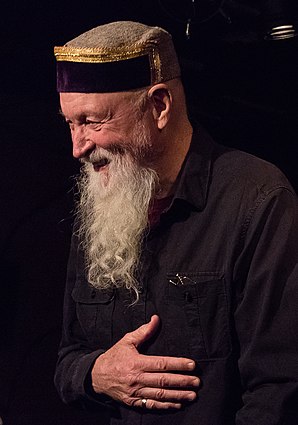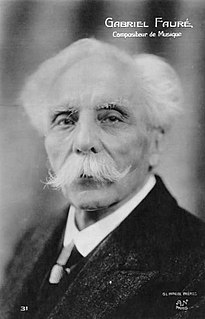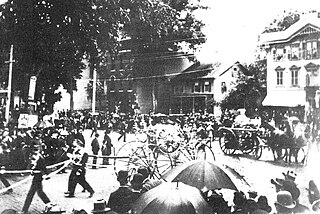Related Research Articles

Terrence "Terry" Mitchell Riley, is an American composer and performing musician best known as a pioneer of the minimalist school of composition. Influenced by jazz and Indian classical music, his music became notable for its innovative use of repetition, tape music techniques, and delay systems. He produced his best known works in the 1960s: the 1964 composition In C and the 1969 LP A Rainbow in Curved Air, both considered landmarks of minimalism and important influences on experimental, rock, and contemporary electronic music.

Malcolm Benjamin Graham Christopher Williamson, AO, CBE was an Australian composer. He was the Master of the Queen's Music from 1975 until his death.

Carl Wilhelm Eugen Stenhammar was a Swedish composer, conductor and pianist.

The Piano Quintet in E-flat major, Op. 44, by Robert Schumann was composed in 1842 and received its first public performance the following year. Noted for its "extroverted, exuberant" character, Schumann's piano quintet is considered one of his finest compositions and a major work of nineteenth-century chamber music. Composed for piano and string quartet, the work revolutionized the instrumentation and musical character of the piano quintet and established it as a quintessentially Romantic genre.

Franz Schubert's final chamber work, the String Quintet in C major is sometimes called the "Cello Quintet" because it is scored for a standard string quartet plus an extra cello instead of the extra viola which is more usual in conventional string quintets. It was composed in 1828 and completed just two months before the composer's death. The first public performance of the piece did not occur until 1850, and publication occurred three years later in 1853. Schubert's only full-fledged string quintet, it has been praised as "sublime" or "extraordinary" and as possessing "bottomless pathos," and is generally regarded as Schubert's finest chamber work as well as one of the greatest compositions in all chamber music.

Sir Edward Elgar's Introduction and Allegro for Strings, Op. 47, was composed in 1905 for performance in an all-Elgar concert by the newly formed London Symphony Orchestra. Scored for string quartet and string orchestra, Elgar composed it to show off the players' virtuosity. Though initial critical reception was lukewarm at best, the score soon came to be recognized as a masterpiece. The work, which is roughly twelve to fourteen minutes in length, is like a multi-layered symphonic poem for string orchestra, with several prominent themes.
John Roger Smalley was an Anglo-Australian composer, pianist and conductor. Professor Smalley was a senior honorary research fellow at the School of Music, University of Western Australia in Perth and honorary research associate at the University of Sydney.
The Quintet in A minor for Piano and String Quartet, Op. 84 is a chamber work by Edward Elgar.
Raymond Henry Charles Warren is a British composer and university teacher.
Antonín Dvořák's Piano Quintet No. 2 in A major, Op. 81, B. 155, is a quintet for piano, 2 violins, viola, and cello. It was composed between August 18 and October 8, 1887, and was premiered in Prague on January 6, 1888. The quintet is acknowledged as one of the masterpieces in the form, along with those of Schumann, Brahms and Shostakovich.

Yitzhak Yedid is an Israeli-Australian composer and pianist.
Ronald Charles Douglas Hanmer was a British conductor, composer and arranger of light music, who spent his latter years in Australia. He was best known for his themes to the Adventures of P.C. 49 and Blue Hills, and is also noted for his large oeuvre of light orchestral and brass band compositions, as well as his arrangements of popular stage musicals. During the 1950s and 1960s he directed his own Latin-American percussion ensemble called "The Marimberos" on BBC radio and was, for a while, conductor of the Sydney Thompson Old-Time Orchestra for the programme "Take Your Partners".
Mark Grey is an American classical music composer, sound designer and sound engineer.
Felix Mendelssohn began composing his Piano Quartet No. 3 in B minor, Op. 3, for piano, violin, viola and cello in late 1824 and completed it on 18 January 1825, just before his sixteenth birthday. The quartet was published later that year and was dedicated to Goethe whom Mendelssohn had met a few years earlier. Mendelssohn's three numbered piano quartets were the first works of his to be published, hence their opus numbers.
John Carmichael OAM is an Australian pianist, composer and music therapist who has long been resident in the United Kingdom. One of his best known works is the Concierto folklorico for piano and string orchestra. His works for piano form much of his musical output, although he composes for many other instruments. His work is described as expressive and lyrical.

The String Quartet in E minor, Op. 121, is the only string quartet by Gabriel Fauré. Completed in 1924 shortly before his death at the age of 79, it is his last composition. His pupil Maurice Ravel had dedicated his String Quartet to Fauré in 1903, and he and others urged Fauré to compose one of his own; he declined, on the grounds that it was too difficult. When he finally decided to write it, he did so in trepidation.
Victor Sangiorgio is an Australian classical pianist. He was born in Italy, grew up and trained in Australia, resides in London and performs internationally.
Six sonatas for various instruments, composed by Claude Debussy, French musician was a projected cycle of sonatas that was interrupted by the composer's death in 1918, after he had composed only half of the projected sonatas. He left behind his sonatas for cello and piano (1915), flute, viola and harp (1915), and violin and piano (1916–1917).
Parry's String Quartet in G major was composed in 1878, the year before he composed his Piano Quintet and Cello Sonata, first performed in 1880, the work remained unpublished during the composers lifetime and was considered lost until it was discovered amongst Gerald Finzi's papers in the 1990s.

The Gong on the Hook and Ladder, or Firemen's Parade on Main Street, normally shortened as The Gong on the Hook and Ladder and also initially entitled Allegro moderato, is a short composition by American composer Charles Ives.
References
- Notes
- 1 2 ( Carmichael 2001 )
- ↑ "John Carmichael – discovery in melody". Scotch College, Melbourne. 24 June 2013. Retrieved 20 September 2014.
- Sources
- Carmichael, John (2001). Liner notes to a live recording of the Piano Quartet "Sea Changes" by the Australian Piano Quartet. City of Perth.